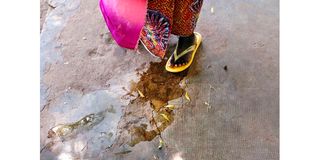Global drive seeks to beat shame of obstetric fistula

Fistula complications are mainly a result of prolonged labour pain and women and girls with the challenge face stigma in society.
What you need to know:
- The United Nations Populations Fund (UNFPA) is spearheading a global campaign to end obstetric fistula, having so far covered more than 55 countries.
- The campaign has helped restore the health, dignity and sense of self-worth of more than 100,000 of the world’s poorest and marginalised women and girls.
Many women and girls suffering from obstetric fistula normally have to grapple with a life of exclusion, shame and ridicule.
Because of the constant smell of urine, they are usually shunned by people, including relatives and friends, and others abandoned by their husbands.
And even though the condition is curable, many victims continue to suffer in silence due to cost implication and lack of specialised healthcare.
However, they could have a sigh of relief if an ongoing global campaign to contain the disease and restore the dignity of victims is anything to go by.
The United Nations Populations Fund (UNFPA) is spearheading a global campaign to end obstetric fistula, having so far covered more than 55 countries across Africa, Asia and the Arab world. It is focusing on four pillars of prevention, treatment, rehabilitation and re-integration.
Since its inception, the campaign has helped restore the health, dignity and sense of self-worth of more than 100,000 of the world’s poorest and marginalised women and girls by repairing fistulas and providing rehabilitation and reintegration services and support.
The UN agency has been providing technical support to reinforce National Task Forces for Fistula and supporting its country offices to help them integrate the sexual and reproductive health programme component with activities on obstetric fistula.
This assistance is mainly supported by the Maternal Health Thematic Fund.
Most UNFPA country programmes are supporting fistula prevention–by reinforcing maternity waiting homes and midwifery programmes–and treatment, providing equipment and supplies, and training providers.
Obstetric fistula results when a baby gets stuck during childbirth, causing a devastating injury as a hole forms between the birth canal and bladder or rectum, leading to uncontrollable leak of urine and faeces.
Triggers
The physical causes are limited access to healthcare, including essential obstetric care during pregnancy and childbirth, adolescent fertility (early marriage), and existing harmful practices such as female genital mutilation (FGM), which affect normal delivery.
UNPA indicates that obstetric fistula is still increasing because health systems fail to provide essential and emergency obstetric care during pregnancy and childbirth, including family planning and the affordable treatment of fistula.
UN Secretary General Antonio Guterres, in a report dubbed Intensifying efforts to end obstetric fistula within a decadeand presented to the UN General Assembly in 2020, noted that women with fistula are evidence of the failure of health systems to deliver universally accessible, timely, and quality obstetric care.
Mr Guterres observed obstetric fistula and severe maternal morbidity is fully preventable when women and girls have access to comprehensive sexual and reproductive health services.
“Sustainable solutions to ending fistula, therefore, require well-functioning, strengthened health systems, well-trained health professionals, access to and supply of essential medicines and equipment and equitable access to high-quality health services, as well as community empowerment,” said Mr Guterres.
The UN boss emphasised on the importance of ensuring that all fistula survivors, including those deemed incurable or inoperable, have access to social reintegration services, including healthcare, counselling and family and community support.
He also underscored the need to develop and strengthen systems and follow-up mechanisms to make fistula a nationally notifiable condition, including indicators to track the well-being and reintegration of fistula survivors, ensuring a human rights-based approach.
He added strategies to assist women in preventing another fistula after successful repair, including education, family planning and caesarean delivery planning are also paramount.
According to the World Health Organisation (WHO), the development of obstetric fistula is directly linked to one of the major causes of maternal mortality: obstructed labour.
Obstetric fistula is preventable and can largely be avoided by delaying the age of first pregnancy, the cessation of harmful traditional practices and timely access to obstetric care.
Local efforts
In 2020, during celebrations to mark International Day to End Obstetric Fistula, First Lady Margaret Kenyatta encouraged pregnant women to continue seeking antenatal services for safe delivery of their babies by skilled birth professionals.
The First Lady observed that although Kenya has in the past couple of years registered encouraging decline in maternal mortality, pregnancy related complications such as the obstetric fistula and other conditions continue to be a public health concern.
Mrs Kenyatta pointed out that through her Beyond Zero medical safaris, held in partnership with Amref in Narok, Kisumu, West-Pokot, Nyandarua and Nairobi counties, about 856 women and girls benefitted from free screening and a total of 193 free fistula repairs and treatment.
“We have supported these women to integrate back into their communities and supported the training of 136 community healthcare workers who are the frontline caregivers for women and girls,” she said.
Obstetric Fistula affects women who lack access to quality obstetric care. The disease is more prevalent among women living in communities whose cultural practices increase the risk of prolonged obstructed labour leading to the condition.
The Ministry of Health in 2019 launched a national strategic framework against obstetric fistula in the country.
The framework dubbed the ‘National Strategic Framework on Female Genital Fistula: Towards a Free Fistula Nation’ was the first of its kind in Africa.
According to MoH 2018 data, the prevalence of genital fistula in Kenya is 1 percent with over 1,000 cases being recorded every year.
While the prevalence of obstetric fistula in the East and Southern Africa region is unknown, it is estimated that two million women in sub-Saharan Africa, Asia, the Arab region, Latin America and the Caribbean are living with this injury.





